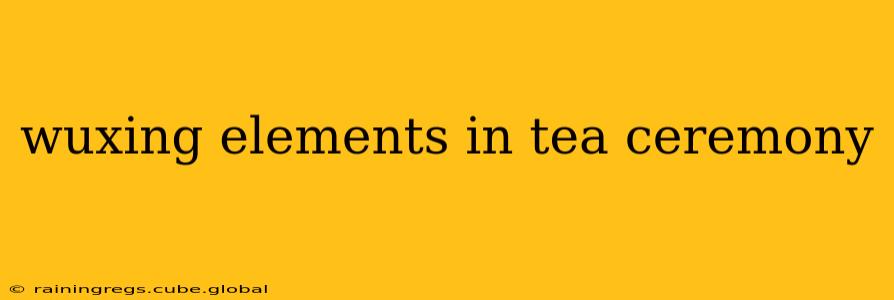The Chinese tea ceremony, steeped in tradition and philosophy, is more than just a ritual; it's a carefully orchestrated performance embodying the principles of Wu Xing (五行), the five elements: Wood, Fire, Earth, Metal, and Water. Understanding these elements reveals a deeper appreciation for the ceremony's aesthetic, symbolic meaning, and its connection to the natural world. This exploration delves into how each element manifests in this refined practice.
What are the Five Elements (Wu Xing)?
Before diving into the specifics of the tea ceremony, let's briefly revisit the core concept of Wu Xing. These five elements aren't just physical substances; they represent cyclical processes, interconnected phases of transformation and interaction, influencing everything from nature's rhythms to human health and well-being. They are characterized by their unique qualities and relationships:
- Wood (木): Growth, expansion, flexibility, springtime.
- Fire (火): Passion, transformation, summer.
- Earth (土): Stability, nurturing, late summer.
- Metal (金): Precision, clarity, autumn.
- Water (水): Flow, introspection, winter.
How are the Wu Xing Elements Reflected in the Tea Ceremony?
The Wu Xing elements are subtly, yet powerfully, woven into every aspect of the tea ceremony, from the preparation to the ambiance and the experience itself.
Wood: The Growth and Origin of Tea
The Wood element is represented by the tea plant itself – its growth, its cultivation, and its journey from bud to leaf. The careful tending of the tea bushes, the nurturing of the soil, and the process of harvesting are all acts reflecting the essence of Wood’s expansive energy. The unfurling of the leaves in the hot water mirrors this growth visually, symbolizing renewal and vitality.
Fire: The Transformation Through Boiling Water
The Fire element is embodied in the boiling water, the transformative force that unlocks the tea's potential. The heat of the water, the vibrant red of the boiling kettle (often traditionally made of iron or clay), and the lively steam rising – all symbolize the passionate and dynamic energy of Fire. This stage marks a crucial transition, the potential energy of the dry leaves becoming fully realized.
Earth: The Teacup and the Ceremony's Grounding
The Earth element finds its expression in the teacup itself, often made of clay, representing the stable and nurturing foundation of the ceremony. The grounding nature of the ceremony, the quiet contemplation, and the focus on the present moment all align with Earth’s grounded energy. The ritualistic preparation and the shared experience create a sense of stability and connection.
Metal: The Precision of the Tools and Movements
The Metal element is evident in the precision of the tools used in the tea ceremony – the meticulously crafted teapot, the refined tea scoop, and the delicate movements of the practitioner. The careful attention to detail, the clean lines, and the precise actions reflect Metal’s qualities of clarity and precision. The act of brewing itself, with its measured steps, emphasizes the element of controlled refinement.
Water: The Essence of Tea and the Flow of the Ceremony
The Water, the most fundamental element, is undeniably central to the tea ceremony. It is the vehicle that extracts the essence of the tea leaves, awakening their flavors and aromas. The flow of water from the kettle to the teapot, the gentle pouring of the tea, and the smooth, flowing movements of the practitioner all highlight Water’s qualities of fluidity and adaptation.
Frequently Asked Questions
What is the significance of the teaware in relation to Wu Xing?
The materials and shapes of the teaware often relate to the elements. Clay teapots represent Earth, while metal teapots represent Metal. The overall design and aesthetics also reflect a balance and harmony between the elements.
How does the tea ceremony balance the five elements?
The successful tea ceremony aims for a harmonious balance of the five elements. This balance is reflected in the thoughtful selection of tea, water temperature, teaware, and the overall atmosphere of the ceremony. Each element plays a vital role, and an imbalance can disrupt the flow and experience.
Can anyone participate in a Wu Xing-infused tea ceremony?
Absolutely! While understanding the philosophical underpinnings enhances appreciation, the beauty of the tea ceremony lies in its ability to be experienced on multiple levels. Even without deep knowledge of Wu Xing, the meditative and aesthetically pleasing aspects of the ceremony are accessible and enjoyable.
By understanding the subtle interplay of the Wu Xing elements within the tea ceremony, we gain a deeper appreciation for its richness, its philosophical depth, and its profound connection to the natural world. It is a journey of mindful participation, connecting with the elements and finding harmony within oneself.
